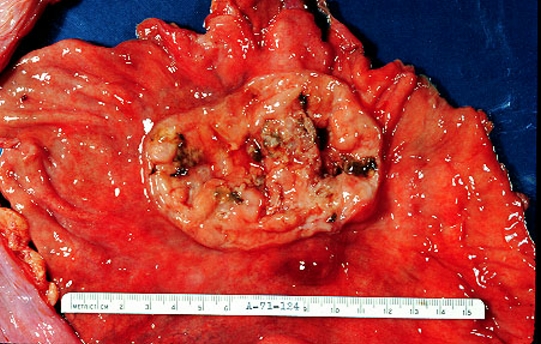Stomach cancer is more common in developing nations, while becoming less common in Western countries, including Australia. At present, stomach cancer is still the fourth most common cause of death from cancer. Slightly more men than women develop stomach cancer. It can occur in young adults, although most commonly it affects people in their late 60s to 70s.
Stomach cancer is curable if detected early, but most people don’t seek medical help until the disease is quite advanced, possibly because symptoms occur late and are often vague and non-specific.
There appear to be two main types of gastric (stomach) cancer.
One type of gastric cancer is associated with infection by the Helicobacter pylori (H. pylori) bacterium. The H. pylori germ commonly lives in the lining of the stomach in up to four out of 10 adults. It is now known to be responsible for most duodenal ulcers and over two-thirds of stomach ulcers. It also triggers symptoms like indigestion.
H. pylori is always associated with superficial gastritis and, sometimes with chronic atrophic gastritis, which can lead to the development of stomach cancer. However, only a minority of people infected with this bacterium ever develop gastric cancer.
Another type of gastric cancer is not associated with Helicobacter pylori. It is less common, but is becoming more so. The cause of this second type is unknown, although reflux – acid regurgitation into the upper stomach and oesophagus (swallowing tube) – and obesity are thought to be important risk factors.
MALToma, which are tumours involving mucosa-associated lymphoid tissue (MALT), and gastrointestinal stromal tumours (GIST) are two other, more rare forms of stomach cancer.
The lining of the stomach, called the epithelium, is layered with multiple folds. The epithelium is coated with mucus (gastric mucosa) secreted by special glands. Stomach cancer seems to progress through certain stages, including:
Before the discovery of the Helicobacter pylori bacterium in 1983, peptic (stomach) ulcers were thought to be caused by diet and stress. The germs inhabit the stomach lining, and the chemicals they produce cause irritation and inflammation. The infection is more common among poor or institutionalised people.
The mode of transmission is mostly unknown, but is thought to include sharing food or utensils, or coming in contact with infected vomit or faeces. The decline of H. pylori rates in the Western world may be related to clean water supplies and the use of antibiotics in childhood. Countries where water from wells is still used have very high H. pylori rates.
It seems logical to assume that a person with stomach ulcers is susceptible to stomach cancer, since the H. pylori bacterium is obviously present. However, this isn’t the case. It apparently depends on the reaction of the stomach to the infection. Research is ongoing, but current theories suggest that stomach ulcers are not a risk factor for stomach cancer.
It is thought that dietary factors, in combination with H. pylori infection, make the development of stomach cancer more likely, for reasons unknown. High-salt diets seem to increase the risk, which may help to explain why the incidence of stomach cancer is declining at a slower rate in Japan (where salt consumption is high). Refrigeration eliminates the need to use salt as a preservative and this could be partly responsible for the declining stomach cancer rate in the West.
Research suggests that eating fruits and vegetables decreases the risk, with vitamin C and carotenoids believed to be the key cancer-inhibiting ingredients. These dietary factors do not seem to be as important as H. pylori infection, however, in determining the risks of developing cancer. Workplace factors may also play a part; workers in the metal industry appear to be at higher risk.
Approximately one in 10 people with stomach cancer have a first degree relative – a parent, brother or sister – with the same disease. Some of these people have an inherited form. Clues to this inherited form are stomach cancer occurring in three or more relatives and occurring at an earlier age (sometimes as young as 20 to 30 years). A defective gene has been found to be responsible and genetic testing for this is possible.
H. pylori is a known risk factor for the development of stomach cancer. Infection can be checked with a simple breath test. If the bacterium is present, a range of medications, including antibiotics, can be used to destroy the infection. Subsequent breath tests are needed to make sure the drugs were successful.
Current research suggests that increasing the daily intake of fruits and vegetables, particularly those high in vitamin C and carotenoids, may further reduce the risk of stomach cancer. Early detection is also important and it is essential to report indigestion to your doctor during regular health checks.
Stomach cancer is curable if detected early, but most people don’t seek medical help until the disease is quite advanced, possibly because symptoms occur late and are often vague and non-specific.
Types of stomach cancer
There appear to be two main types of gastric (stomach) cancer.
One type of gastric cancer is associated with infection by the Helicobacter pylori (H. pylori) bacterium. The H. pylori germ commonly lives in the lining of the stomach in up to four out of 10 adults. It is now known to be responsible for most duodenal ulcers and over two-thirds of stomach ulcers. It also triggers symptoms like indigestion.
H. pylori is always associated with superficial gastritis and, sometimes with chronic atrophic gastritis, which can lead to the development of stomach cancer. However, only a minority of people infected with this bacterium ever develop gastric cancer.
Another type of gastric cancer is not associated with Helicobacter pylori. It is less common, but is becoming more so. The cause of this second type is unknown, although reflux – acid regurgitation into the upper stomach and oesophagus (swallowing tube) – and obesity are thought to be important risk factors.
MALToma, which are tumours involving mucosa-associated lymphoid tissue (MALT), and gastrointestinal stromal tumours (GIST) are two other, more rare forms of stomach cancer.
The progression of stomach cancer
The lining of the stomach, called the epithelium, is layered with multiple folds. The epithelium is coated with mucus (gastric mucosa) secreted by special glands. Stomach cancer seems to progress through certain stages, including:
- Normal mucus lining
- Superficial gastritis (inflammation)
- Chronic atrophic gastritis
- Intestinal metaplasia (cell changes)
- Dysplasia and carcinoma (development of cancer cells).
Helicobacter pylori
Before the discovery of the Helicobacter pylori bacterium in 1983, peptic (stomach) ulcers were thought to be caused by diet and stress. The germs inhabit the stomach lining, and the chemicals they produce cause irritation and inflammation. The infection is more common among poor or institutionalised people.
The mode of transmission is mostly unknown, but is thought to include sharing food or utensils, or coming in contact with infected vomit or faeces. The decline of H. pylori rates in the Western world may be related to clean water supplies and the use of antibiotics in childhood. Countries where water from wells is still used have very high H. pylori rates.
Stomach ulcers aren’t a risk factor
It seems logical to assume that a person with stomach ulcers is susceptible to stomach cancer, since the H. pylori bacterium is obviously present. However, this isn’t the case. It apparently depends on the reaction of the stomach to the infection. Research is ongoing, but current theories suggest that stomach ulcers are not a risk factor for stomach cancer.
Dietary and workplace factors
It is thought that dietary factors, in combination with H. pylori infection, make the development of stomach cancer more likely, for reasons unknown. High-salt diets seem to increase the risk, which may help to explain why the incidence of stomach cancer is declining at a slower rate in Japan (where salt consumption is high). Refrigeration eliminates the need to use salt as a preservative and this could be partly responsible for the declining stomach cancer rate in the West.
Research suggests that eating fruits and vegetables decreases the risk, with vitamin C and carotenoids believed to be the key cancer-inhibiting ingredients. These dietary factors do not seem to be as important as H. pylori infection, however, in determining the risks of developing cancer. Workplace factors may also play a part; workers in the metal industry appear to be at higher risk.
Inherited forms of stomach cancer
Approximately one in 10 people with stomach cancer have a first degree relative – a parent, brother or sister – with the same disease. Some of these people have an inherited form. Clues to this inherited form are stomach cancer occurring in three or more relatives and occurring at an earlier age (sometimes as young as 20 to 30 years). A defective gene has been found to be responsible and genetic testing for this is possible.
Reducing the risk
H. pylori is a known risk factor for the development of stomach cancer. Infection can be checked with a simple breath test. If the bacterium is present, a range of medications, including antibiotics, can be used to destroy the infection. Subsequent breath tests are needed to make sure the drugs were successful.
Current research suggests that increasing the daily intake of fruits and vegetables, particularly those high in vitamin C and carotenoids, may further reduce the risk of stomach cancer. Early detection is also important and it is essential to report indigestion to your doctor during regular health checks.
Where to get help
- Your doctor
- Gastroenterologist
- The Cancer Council Victoria, Cancer Information and Support Service Tel. 131 120
Things to remember
- Stomach cancer is more common in developing nations, while becoming less so in Western countries, including Australia.
- Stomach cancer is thought to be triggered by infection with the Helicobacter pylori bacterium, possibly working in combination with diet.






